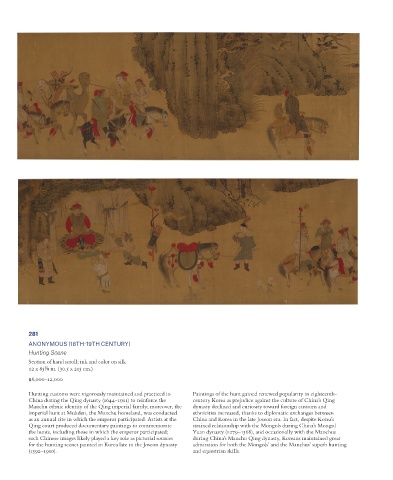Page 443 - japanese and korean art Utterberg Collection Christie's March 22 2022
P. 443
281
ANONYMOUS (18TH-19TH CENTURY)
Hunting Scene
Section of hand scroll; ink and color on silk
12 x 83√ in. (30.5 x 213 cm.)
$8,000-12,000
Hunting customs were vigorously maintained and practiced in Paintings of the hunt gained renewed popularity in eighteenth-
China during the Qing dynasty (1644–1911) to reinforce the century Korea as prejudice against the culture of China’s Qing
Manchu ethnic identity of the Qing imperial family; moreover, the dynasty declined and curiosity toward foreign customs and
imperial hunt at Mukden, the Manchu homeland, was conducted ethnicities increased, thanks to diplomatic exchanges between
as an annual rite in which the emperor participated. Artists at the China and Korea in the late Joseon era. In fact, despite Korea’s
Qing court produced documentary paintings to commemorate strained relationship with the Mongols during China’s Mongol
the hunts, including those in which the emperor participated; Yuan dynasty (1279–1368), and occasionally with the Manchus
such Chinese images likely played a key role as pictorial sources during China’s Manchu Qing dynasty, Koreans maintained great
for the hunting scenes painted in Korea late in the Joseon dynasty admiration for both the Mongols’ and the Manchus’ superb hunting
(1392–1910). and equestrian skills.

